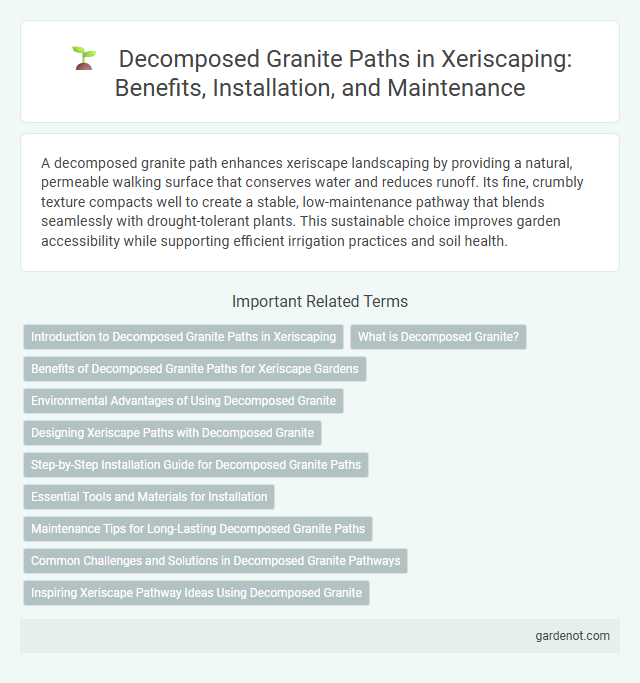A decomposed granite path enhances xeriscape landscaping by providing a natural, permeable walking surface that conserves water and reduces runoff. Its fine, crumbly texture compacts well to create a stable, low-maintenance pathway that blends seamlessly with drought-tolerant plants. This sustainable choice improves garden accessibility while supporting efficient irrigation practices and soil health.
Introduction to Decomposed Granite Paths in Xeriscaping
Decomposed granite paths offer a sustainable and low-water landscaping solution ideal for xeriscaping, providing durability and natural aesthetics. This material, composed of finely crushed granite rocks, compacts well to create stable walkways that minimize water runoff and soil erosion. Incorporating decomposed granite emphasizes water conservation while enhancing garden accessibility and complementing drought-tolerant plantings.
What is Decomposed Granite?
Decomposed granite is a natural material composed of finely broken-down granite rock, creating a durable and permeable surface ideal for xeriscape pathways. Its composition allows excellent drainage and minimal erosion, making it an eco-friendly and low-maintenance choice for sustainable landscaping. Decomposed granite paths provide a stable, slip-resistant walking surface that blends naturally with desert or drought-tolerant garden designs.
Benefits of Decomposed Granite Paths for Xeriscape Gardens
Decomposed granite paths offer excellent permeability, reducing runoff and promoting water absorption in xeriscape gardens. Their natural, earthy tones blend seamlessly with drought-tolerant plants, enhancing garden aesthetics while minimizing maintenance. This durable material resists erosion and withstands foot traffic, making it an ideal sustainable choice for conserving water.
Environmental Advantages of Using Decomposed Granite
Decomposed granite paths reduce water consumption by allowing rainwater to permeate the ground, promoting natural groundwater recharge. This material is made from natural granite that breaks down over time, minimizing environmental impact and supporting sustainable landscaping practices. Its permeability and erosion resistance also help prevent soil degradation and reduce runoff pollution.
Designing Xeriscape Paths with Decomposed Granite
Designing xeriscape paths with decomposed granite provides a sustainable, low-maintenance solution that conserves water and enhances natural aesthetics. Decomposed granite offers excellent permeability, reducing runoff while its warm, earthy tones blend seamlessly with drought-tolerant plants like native succulents and ornamental grasses. Proper installation involves compacting the granite base and applying stabilizers to prevent erosion and maintain durability in arid landscapes.
Step-by-Step Installation Guide for Decomposed Granite Paths
Start by excavating the path area to a depth of 4-6 inches, ensuring proper slope for drainage. Next, compact the soil base and lay a landscape fabric to prevent weed growth, then spread a 2-3 inch layer of decomposed granite evenly across the path. Finally, moisten the granite and compact it using a plate compactor for a stable, durable surface ideal for xeriscape gardens.
Essential Tools and Materials for Installation
Installing a decomposed granite path requires essential tools such as a landscape rake for leveling, a tamper for compacting, and edging materials to maintain the path's shape. Key materials include decomposed granite aggregate, a stabilizer to prevent erosion, and a weed barrier fabric to inhibit unwanted growth beneath the surface. Proper preparation and the right combination of tools and materials ensure a durable, low-maintenance xeriscape pathway ideal for water conservation landscapes.
Maintenance Tips for Long-Lasting Decomposed Granite Paths
Regularly rake decomposed granite paths to maintain a smooth, even surface and prevent weed growth. Apply a stabilizer or compact the granite periodically to reduce erosion and dust. Keep edges bordered with metal or stone to minimize gravel displacement and prolong the path's durability.
Common Challenges and Solutions in Decomposed Granite Pathways
Decomposed granite pathways often face challenges such as erosion, weed growth, and surface compacting, which can lead to uneven walking surfaces and maintenance difficulties. Solutions involve applying stabilizers or binders to enhance durability, regularly integrating weed barriers to prevent unwanted plant growth, and routine grading to maintain smoothness and proper drainage. Proper installation techniques, including adequate base preparation and edge restraint, significantly reduce common issues associated with decomposed granite in xeriscape landscaping.
Inspiring Xeriscape Pathway Ideas Using Decomposed Granite
Decomposed granite pathways provide a sustainable and visually appealing option for xeriscape landscapes, enhancing water efficiency while maintaining natural aesthetics. This material compacts well for stable walkways and offers excellent drainage, reducing soil erosion and minimizing water runoff in arid environments. Incorporating decomposed granite with native drought-tolerant plants and strategically placed solar lighting creates an inviting and eco-friendly xeriscape pathway.
Decomposed granite path Infographic

 gardenot.com
gardenot.com